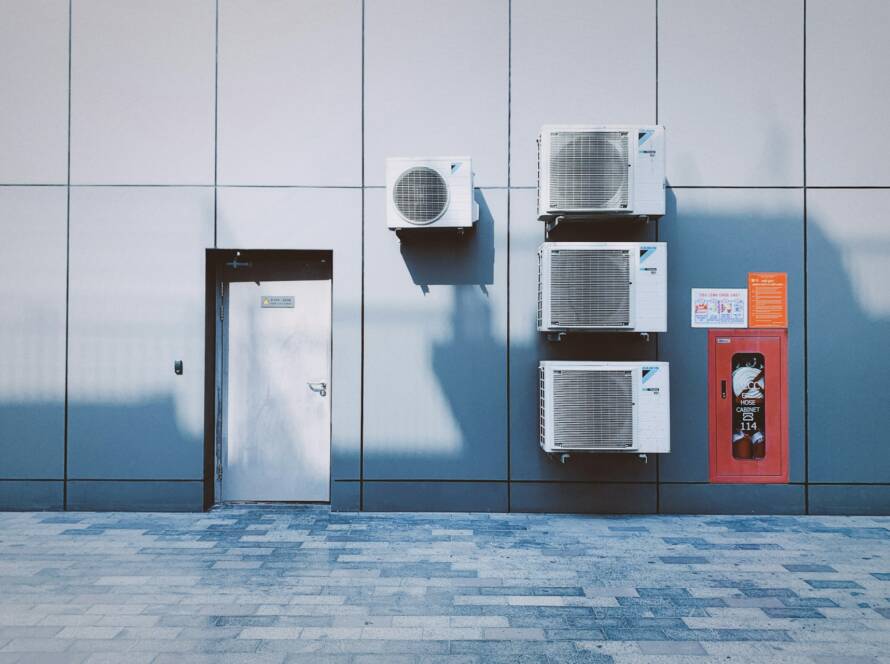You discover black spots growing on your office walls. Your employees start calling in sick with respiratory problems. Your insurance company denies your claim. The cleanup costs £30,000 and your business has to shut down for two weeks. This nightmare scenario happens to businesses every day, but it’s completely preventable.
Mold isn’t just unsightly – it’s a serious business threat that can destroy your property, harm your employees, and cost you thousands in cleanup and legal fees.
The Hidden Business Costs of Mold
When mold takes hold in your building, the financial impact hits from multiple directions:
Expensive remediation. Professional mold removal typically costs £10,000-£50,000 or more, depending on the extent of the problem. You might need to tear out walls, replace flooring, and rebuild damaged areas.
Business interruption. If mold is discovered in your workplace, you may need to close temporarily while cleanup happens. This means lost productivity, cancelled meetings, and potentially lost customers.
Health-related claims. Employees who get sick from mold exposure can file workers’ compensation claims. Some develop long-term respiratory problems that require ongoing medical treatment.
Legal liability. You could face lawsuits from employees, tenants, or customers who suffer health problems from mold exposure. Even if you win, legal defense costs can be substantial.
Insurance complications. Many insurance policies exclude mold damage, especially if it results from ongoing moisture problems you failed to address. Even covered claims can be disputed and expensive.
Property value loss. Buildings with mold history are harder to sell or rent and often sell for significantly less money. The stigma can last for years.
Where Mold Strikes Without Warning
Mold grows in places you don’t regularly inspect, making it particularly dangerous for businesses:
Behind walls. Pipe leaks or trapped moisture can create perfect growing conditions inside walls. You might not notice until you see stains or smell musty odors – by then, extensive damage has occurred.
Under flooring. Basements and ground-floor areas can trap moisture from leaks or high humidity. Mold growing under floors can spread throughout your building through ventilation systems.
In ceiling spaces. Roof leaks or air conditioning condensation can create ideal conditions above ceiling tiles. The mold thrives while you remain unaware.
Around windows and doors. These areas often have small leaks or condensation that provide just enough moisture for mold to establish itself.
In HVAC systems. Heating and cooling systems can have moisture buildup that creates perfect growing conditions, then spread mold spores throughout your entire building.
Why Traditional Mold Prevention Fails
Most businesses rely on methods that only catch problems after expensive damage has occurred:
Visual inspections only find mold after it’s already established and visible. Early-stage moisture problems that create ideal growing conditions are often invisible.
Reactive maintenance addresses problems only after water damage or mold growth is discovered, making solutions much more expensive and disruptive.
Basic humidity meters show conditions at one location and time but can’t track changes over time or monitor multiple areas simultaneously.
Waiting for complaints means investigating moisture problems only after employees notice musty smells or visible mold. By then, expensive remediation is often necessary.
The Science of Mold Prevention
Understanding how mold grows helps you prevent it effectively. Mold needs three things:
- Moisture (water or high humidity)
- Food (almost any building material)
- Temperature (usually between 40°F and 100°F)
Since buildings contain materials mold can consume and temperatures are usually in the right range, moisture is the only factor you can control. Keep moisture levels below 60% relative humidity, and mold cannot grow.
The key is catching moisture problems before mold can establish itself. Under ideal conditions, mold can begin growing within 24-48 hours of getting wet. Within days, it can spread to cover large areas.
Smart Monitoring: Your Defense Against Mold
Companies like SmartSenser have developed systems that monitor moisture conditions continuously throughout your building. Think of it as having a moisture expert checking every corner of your facility 24/7.
Comprehensive monitoring places sensors throughout your building to track humidity, temperature, and moisture levels in walls, ceilings, and other hidden areas where mold problems typically start.
Real-time alerts notify you immediately when moisture levels start rising to dangerous levels, allowing you to address problems before mold can begin growing.
Historical tracking identifies patterns and problem areas, helping you understand your building’s behavior and predict when conditions might become dangerous.
Integration with building systems connects with HVAC systems, dehumidifiers, and ventilation equipment to automatically adjust conditions when moisture levels start rising.
Remote monitoring lets you check moisture conditions throughout your property from anywhere using smartphones or computers.
The Business Case for Smart Monitoring
Prevention costs less than remediation. Smart monitoring systems typically cost £2,000-£10,000 to install, while mold remediation can cost £10,000-£50,000 or more. Preventing one major mold incident pays for the system multiple times over.
Early detection saves money. Catching moisture problems within hours or days instead of weeks or months allows for quick, inexpensive fixes before serious damage occurs.
Reduced insurance claims. Preventing mold problems reduces the likelihood of expensive insurance claims and potential coverage disputes.
Protected property values. Maintaining proper moisture levels protects your building materials and property value from mold damage.
Employee health protection. Preventing mold growth reduces sick days, workers’ compensation claims, and potential liability issues.
Business continuity. Avoiding mold problems means avoiding business interruptions and temporary closures.
Real Business Success Stories
The office building save. A property management company installed moisture monitoring after one tenant complained about musty smells. The system detected elevated humidity in a wall cavity and alerted maintenance, who found and fixed a small pipe leak. Without monitoring, this would have become a major mold problem requiring £25,000 in remediation.
The school district success. A school installed smart monitoring after discovering mold in one building. The system detected moisture problems in two other buildings before mold could grow, preventing classroom closures and saving an estimated £75,000 in remediation costs.
The retail prevention. A retail chain used moisture monitoring to prevent mold problems in their stores. Early detection of HVAC condensation issues allowed quick fixes that prevented product damage and store closures.
How Smart Monitoring Works in Practice
Strategic sensor placement. Wireless moisture sensors install in areas where problems typically develop – behind walls, under floors, in ceiling spaces, around windows, and in HVAC systems.
Cloud-based intelligence. All sensor data feeds into SmartSenser’s cloud platform, which analyzes moisture patterns, identifies trends, and predicts when conditions might become dangerous.
Automated responses. When moisture levels start rising, the system can automatically trigger responses like increasing ventilation, activating dehumidifiers, or adjusting HVAC settings.
Multi-level alerting. The system sends different types of alerts based on severity. Minor humidity increases might generate emails, while dangerous moisture spikes trigger immediate phone calls.
Detailed reporting. Generate reports showing moisture trends over time, helping you understand your building’s behavior and plan for improvements.
Implementation: Simpler Than You Think
Assessment. SmartSenser evaluates your building to identify areas most prone to moisture problems and recommends optimal sensor placement.
Installation. Wireless sensors install quickly without disrupting operations. Most systems can be operational within days.
Integration. The system works with your existing HVAC and building systems – no need to replace functional equipment.
Training. Your staff learns to use the monitoring dashboard and respond to alerts. The interface is designed to be user-friendly.
Ongoing support. Professional monitoring services provide continuous oversight and technical support.
Immediate Steps You Can Take
While planning for smart monitoring, you can reduce mold risk immediately:
- Fix any water leaks immediately, no matter how small they seem
- Control humidity levels using dehumidifiers or improved ventilation
- Inspect problem areas regularly, including basements, bathrooms, and areas around windows
- Improve ventilation in all areas, especially basements and storage rooms
- Address condensation issues around windows, pipes, and HVAC equipment
- Train employees to report water leaks or musty odors immediately
Your Next Steps
Mold problems are preventable, but only if moisture issues are caught and addressed early. Every day without proper monitoring puts your business at risk of expensive mold remediation and potential health claims.
Evaluate your current risk:
- Do you have areas prone to moisture problems?
- How would mold remediation affect your business operations?
- What would a mold-related lawsuit cost?
Calculate the opportunity:
- What would preventing one major mold incident save you?
- How much do you spend on maintenance and repairs annually?
- What’s the cost of business interruption from mold problems?
Consider smart monitoring:
- Compare system costs to potential remediation expenses
- Look for solutions that integrate with existing building systems
- Choose providers with commercial building experience
Contact SmartSenser:
- Get a customized assessment of your building
- Learn about installation options and costs
- Discuss how monitoring addresses your specific risks
The Bottom Line
Mold prevention isn’t just about maintaining a clean, healthy building – it’s about protecting your business from devastating financial losses. The investment in smart moisture monitoring is minimal compared to the cost of mold remediation, business interruption, and potential legal claims.
Smart monitoring systems provide 24/7 protection at a fraction of the cost of dealing with established mold problems. They catch moisture issues early when they’re easy and inexpensive to fix, preventing them from becoming major disasters.
Your building is a significant investment. Your employees depend on a healthy work environment. Your business operations require continuous facility availability. Smart moisture monitoring protects all three.
Don’t wait for mold to discover your moisture problems. By then, the damage is done and expensive remediation is your only option. Prevention is always cheaper than cure.
The technology exists today to prevent virtually every mold problem before it starts. The question is whether you’ll invest in prevention or gamble with your business and hope problems don’t occur.
Smart monitoring makes that choice easy and affordable. Your business deserves protection from mold’s hidden threats.


